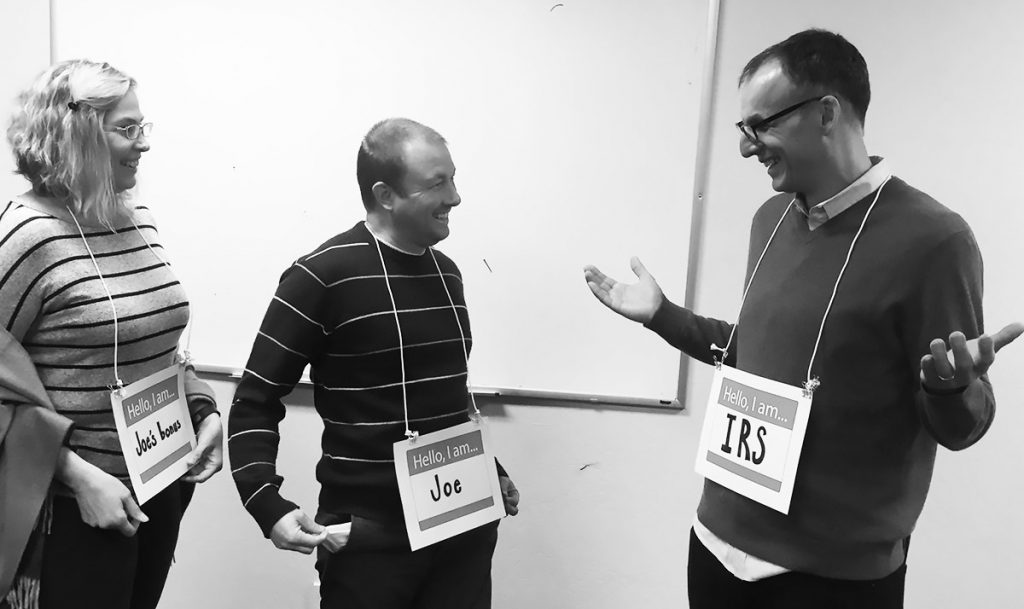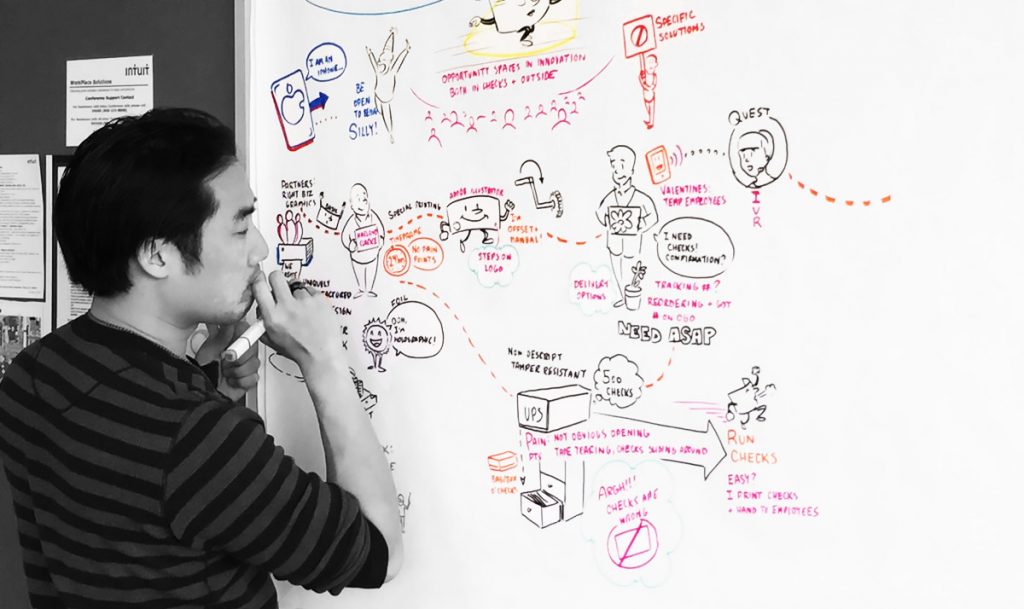This spring, I’ll be teaching a course on design thinking at Stanford Continuing Studies for Business. As I was getting one of my lesson plans together I got pretty excited… so excited, in fact, I’m using this post to give you a preview!
This interactive session will be about what a Journey Acting Workshop can do for you and your organization … AND how you can run your OWN Journey Acting Workshop. Let’s take a look at what’s involved, and how your team can benefit …
Rooted in improvisation
Bob Baxley, formerly of Apple and Pinterest, has talked about doing an improvisational exercise with his team, during which they played out the lifecycle of a product or service. It was called “I am a…” and he and his team worked through all the customer touch points related to the iPhone or a pin to visualize the end-to-end experience.
I loved this idea when I heard about it, and I decided to take it a step further. The result is what I call “Journey Acting.”
Going deep
Journey Acting helps cross-functional teams gain a deeper understanding of their product or service, at every touch point, from end-to-end. The ultimate result, though, is to use this deep understanding to discover areas that are ripe for innovation … areas that your team may have never considered before.
But how would I bring Journey Acting “to the people” … ? Well, that’s where the Workshop comes in! I believe that participating in a Workshop is the first step to understanding how, when, and where your team can create an amazing customer experience!
The fun begins
The facilitator and the team agree on a shared definition of what your product or service is. It could be a physical or non-physical product – marketing anything from, say, bananas to a financial account. Or whatever your organization traffics in.
We start off the day with improvisational warm-ups; from there, we elect someone to play the “Product” or the “Service.” Yes, it’s possible – and fun – to act out a service; for now, though, let’s stay with the product (banana) example.
The facilitator – or, more appropriately at this stage, the master of ceremonies – starts the improv by asking questions, such as “How did the banana originate?” and then “Who originated it?” Then, someone’s elected to play the banana “farmer.” The next questions are along the lines of “Who gets the banana to market?” “What paperwork is needed?” “How long does it take?” and so forth.
Ready … action!
Next, we focus on customers and employees … and examine “artifacts,” barriers, timetables, and outcomes we come across as the process unfolds. We continue through the entire lifecycle of the product, with team members playing various people and processes – whomever and whatever are involved with creating the product and getting it to customers. Everyone plays various parts; there’s even a role for “paperwork”!
Using these improvisational exercises and embodiment techniques, we “think with the physical self” about abstract ideas connected to your product or service. In this way, the story of your offering becomes more, yes, “tangible” to every member of your functional or cross-functional team.

Visual recordkeeping
While all of this improv, role playing, storytelling, and discussion is happening, there’s a graphic facilitator/”visual listener” hard at work, documenting everything on poster-sized paper. This person is listening intently and “translating” what he/she hears into an illustrated “roadmap” to areas of opportunity.
Here are two reasons why visual listening is a key element of the workshop: 1) It helps participants be present in the moment, as they don’t have to worry about documenting anything. 2) It serves as an “artifact” that can be referenced during and after the workshop.

The home stretch
Once the improv has run its course, and we’ve identified all the use-case paths for your product or service, we transition into the next phase. The team “walks the map” together, following the storyline of their product or service and highlighting areas that look ripe for innovation.
From there, the team prioritizes and assigns next steps, such as getting more customer insights or investigating a specific opportunity.
Let’s get paleo
The Journey Acting Workshop reaches back to our most primal ways of distributing information. We use the 150,000-year-old technique of physical storytelling (think about humans acting out stories around the campfire), and the 15,000-year-old tradition of communicating through pictures (think about the Lascaux cave paintings).
Put another way, the workshop empowers you to use the core tools embedded into our DNA to comprehend your product or service – and the end-to-end customer experience of it.
As an individual, when your mind and body work together, you retain and comprehend more. Combine that with the wide perspective of a cross-functional team and you’ll stimulate amazing thinking and innovative ideas.
The f-word again
The Journey Acting Workshop is, yes, FUN! Along with gaining valuable insights, you’ll enjoy a great half or full day of team building. The workshop gets everyone comfortable with feeling a little uncomfortable … which gives your team the courage to make breakthrough innovations for your product or service.
Pay it forward
One other benefit of the Journey Acting Workshop is that you’ll learn how to conduct one of your own! For example, you can repeat the workshop anytime you’re looking to inspire your people … or run the workshop for other teams in your organization. I’ll also discuss additional, easy-to-run Design Thinking Workshops … all of which can help you accelerate your product or service experience into the realm of true customer delight.
Bringing it
If you think your team can benefit from a Journey Acting Workshop (hint: they can!), let’s discuss bringing one to your office or offsite.

